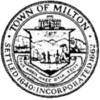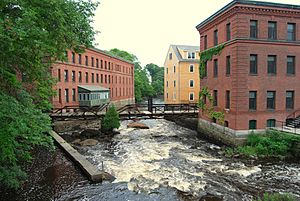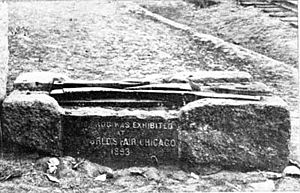Milton, Massachusetts facts for kids
Quick facts for kids
Milton, Massachusetts
|
||
|---|---|---|
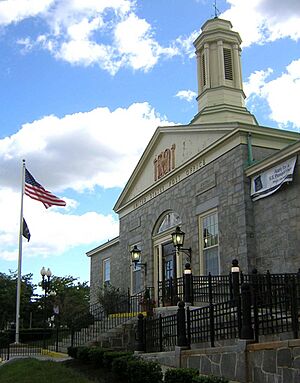
Milton Post Office
|
||
|
||
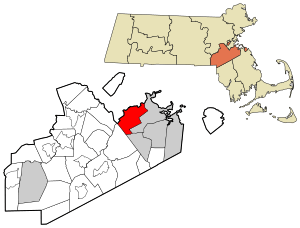
Location in Norfolk County in Massachusetts
|
||
| Country | ||
| State | ||
| County | Norfolk | |
| Settled | 1640 | |
| Incorporated | 1662 | |
| Government | ||
| • Type | Representative town meeting | |
| Area | ||
| • Total | 34.4 km2 (13.3 sq mi) | |
| • Land | 33.8 km2 (13.0 sq mi) | |
| • Water | 0.6 km2 (0.2 sq mi) | |
| Elevation | 40 m (130 ft) | |
| Population
(2020)
|
||
| • Total | 28,630 | |
| • Density | 832.3/km2 (2,153/sq mi) | |
| Time zone | UTC−5 (Eastern) | |
| • Summer (DST) | UTC−4 (Eastern) | |
| ZIP Code |
02186
|
|
| Area code(s) | 617 and 857 | |
| FIPS code | 25-41690 | |
| GNIS feature ID | 0619459 | |
| Website | www.townofmilton.org | |
Milton is a town in Norfolk County, Massachusetts, United States. It's a close neighbor, or "suburb," of Boston. In 2020, about 28,630 people lived there.
Milton is a hilly area located between the Neponset River and the Blue Hills Reservation. It's surrounded by other towns and parts of Boston. To the north, it borders Boston's Dorchester and Mattapan areas. To the west, it's next to Boston's Hyde Park and the town of Canton. Quincy is to the east, and Randolph is to the south.
Contents
History of Milton
Milton was first settled around 1640 by Puritans from England. It was originally part of Dorchester. The local Native American tribe, the Neponset, called the area "Unquity," meaning "Lower Falls." This name later became "Lower Mills" because of a grist mill built there in 1634.
In 1662, the part of Dorchester south of the Neponset River became its own town. It was named Milton, possibly after Milton Abbey in Dorset, England.
Milton was an important industrial area. A powder mill was built in 1674, possibly the first in the colonies. This mill used the town's water power. Investors from Boston helped Milton grow in the 1700s. They built an iron mill, paper mills, and sawmills. In 1764, the first chocolate factory in New England, the Walter Baker Chocolate Factory, opened here. It was made from the old grist mill.
As streetcar lines were built, more homes were added. Between 1870 and 1915, Milton became a "streetcar suburb." This means people could live in Milton and easily travel to Boston by streetcar. Even with new homes, the town still had chocolate, biscuits, and farm produce. By 1929, many large estates were divided into smaller lots for more houses.
An important event in American history happened in Milton. The Suffolk Resolves were signed here in 1774. These resolves were a strong statement against British rule. They even helped inspire the Declaration of Independence in 1776. The Suffolk Resolves House, where this happened, is still standing. It is now the home of the Milton Historical Society. The house was moved to a new spot to save it from being torn down. Milton was part of Suffolk County until 1793. Then, Norfolk County was created.
Two royal governors of Massachusetts lived in Milton. Jonathan Belcher and Thomas Hutchinson both had houses here. The Governor Belcher House, built in 1777, is still privately owned. Governor Hutchinson's house was taken down in the 1940s. But Governor Hutchinson's Field is now a beautiful green space. It offers great views of the Neponset River and Boston's skyline. Both the Belcher House and Hutchinson's Field are listed on the National Register of Historic Places.
Milton was also home to America's first piano factory. The Blue Hill Meteorological Observatory is in Milton. It has the oldest continuous weather records in the country.
The Granite Railway started in 1826. It ran from Quincy to the Neponset River in Milton. Many people call it the first commercial railroad in the United States. A special plaque and a piece of the original track are in East Milton Square. This piece of track was even shown at the Chicago World's Fair in 1893.
In 1801, Josiah Bent started a baking business in Milton. He sold "water crackers" made of flour and water. These crackers lasted a long time, which was great for sea voyages from Boston. The crackling sound they made when baking gave them their name. This is where the American word "cracker" comes from! His company later sold these hard crackers to soldiers during the American Civil War. The company, Bent's Cookie Factory, is still in Milton today.
Robert Bennet Forbes was a famous merchant and sea captain. He helped people during the Irish Famine. He built a large house in Milton in 1833. The Captain Robert Bennet Forbes House is now a museum. It has items from the China Trade era.
George H. W. Bush, who became the 41st President of the United States, was born in Milton on June 12, 1924. His son also became president. The house where President Bush was born is now privately owned.
Geography and Climate
Milton covers about 13.3 square miles (34.4 square kilometers). Most of this area is land, with a small amount of water.
Great Blue Hill is the highest point in Norfolk County. The Blue Hill Meteorological Observatory is at its top. This observatory has the longest continuous weather record in North America.
Milton is known for its wind! It's often called the windiest city in the United States. The average wind speed measured at the Blue Hill Observatory is about 15.4 miles per hour.
| Climate data for Blue Hills Reservation (Blue Hill Meteorological Observatory), 1891−2010 normals, extremes 1885−present | |||||||||||||
|---|---|---|---|---|---|---|---|---|---|---|---|---|---|
| Month | Jan | Feb | Mar | Apr | May | Jun | Jul | Aug | Sep | Oct | Nov | Dec | Year |
| Record high °F (°C) | 68 (20) |
68 (20) |
89 (32) |
94 (34) |
94 (34) |
99 (37) |
100 (38) |
101 (38) |
99 (37) |
88 (31) |
81 (27) |
74 (23) |
101 (38) |
| Mean daily maximum °F (°C) | 33.6 (0.9) |
34.8 (1.6) |
43.4 (6.3) |
54.9 (12.7) |
66.3 (19.1) |
74.6 (23.7) |
80.0 (26.7) |
77.9 (25.5) |
70.9 (21.6) |
60.5 (15.8) |
48.8 (9.3) |
37.4 (3.0) |
56.9 (13.8) |
| Daily mean °F (°C) | 25.7 (−3.5) |
26.4 (−3.1) |
34.4 (1.3) |
44.7 (7.1) |
55.3 (12.9) |
64.1 (17.8) |
69.7 (20.9) |
68.1 (20.1) |
61.2 (16.2) |
51.1 (10.6) |
40.6 (4.8) |
29.8 (−1.2) |
47.6 (8.7) |
| Mean daily minimum °F (°C) | 18.4 (−7.6) |
18.9 (−7.3) |
27.0 (−2.8) |
36.5 (2.5) |
46.4 (8.0) |
55.4 (13.0) |
61.5 (16.4) |
60.3 (15.7) |
53.6 (12.0) |
43.4 (6.3) |
33.7 (0.9) |
22.9 (−5.1) |
39.8 (4.3) |
| Record low °F (°C) | −16 (−27) |
−21 (−29) |
−5 (−21) |
6 (−14) |
27 (−3) |
36 (2) |
44 (7) |
39 (4) |
28 (−2) |
21 (−6) |
5 (−15) |
−19 (−28) |
−21 (−29) |
| Average precipitation inches (mm) | 4.24 (108) |
3.95 (100) |
4.61 (117) |
4.06 (103) |
3.70 (94) |
3.69 (94) |
3.64 (92) |
4.08 (104) |
3.94 (100) |
3.97 (101) |
4.36 (111) |
4.39 (112) |
48.63 (1,236) |
| Average snowfall inches (cm) | 16.0 (41) |
16.1 (41) |
11.7 (30) |
2.9 (7.4) |
0.1 (0.25) |
0.0 (0.0) |
0.0 (0.0) |
0.0 (0.0) |
0.0 (0.0) |
0.3 (0.76) |
2.6 (6.6) |
11.4 (29) |
61.1 (156.01) |
| Mean monthly sunshine hours | 132.1 | 146.7 | 174.0 | 185.6 | 220.2 | 231.8 | 258.1 | 242.5 | 204.1 | 182.1 | 133.3 | 125.9 | 2,236.4 |
| Percent possible sunshine | 46.3 | 50.9 | 48.5 | 47.9 | 50.4 | 52.7 | 58.0 | 58.7 | 56.7 | 55.1 | 47.0 | 45.9 | 51.5 |
| Source: Blue Hill Observatory & Science Center | |||||||||||||
Milton's People
Milton has grown steadily over the years. In 1850, there were 2,241 people. By 2020, the population had grown to 28,630.
Most people in Milton are White (77.4%), with a significant number of Black or African American residents (14.3%). About 4.1% of the population is Asian. Many families in Milton have Irish roots, with 38% of residents saying they have Irish ancestors. This is one of the highest percentages in the United States!
Milton is a place where many people own their homes. About 82% of the houses are owned by the people who live in them. The cost of living here is quite high, with the average house price around $1.02 million.
Arts and Culture
Education in Milton
Milton has a great school system. There are six public schools:
- Four elementary schools: Collicot, Cunningham, Glover, and Tucker.
- One middle school: Pierce Middle School.
- One public high school: Milton High School.
Milton is special because it offers a French immersion program. Students can start learning in French from the first grade!
There are also several private schools in Milton:
- Milton Academy
- Fontbonne Academy
- Thacher Montessori School
- Carriage House School
- Delphi Academy
Catholic schools include St. Mary of the Hills School and St. Agatha's School.
Curry College, a small college focused on liberal arts, is also located in Milton.
Getting Around Milton
Milton is part of the Massachusetts Bay Transportation Authority (MBTA) system. This means you can use public transport to get around. The Mattapan Line is a light rail line that connects Milton to Boston's Red Line. Milton has four stops on this line: Milton, Central Avenue, Valley Road, and Capen Street. This line used to be a steam railway!
Major roads like Massachusetts Route 28 and Massachusetts Route 138 run through Milton. Interstate 93 (which is also U.S. Route 1 and Massachusetts Route 3) goes around the town's southern and eastern edges.
Cycling is a popular way to get around and have fun in Milton. The Neponset River Greenway is a great path that connects Milton to Boston Harbor. Other popular cycling spots include Turner's Pond and the Pine Tree Brook greenway.
The Milton Yacht Club started in 1902. It's located by the Neponset River and is still active today.
Famous People from Milton
- Sophia French Palmer, Nurse and first editor of the American Journal of Nursing
- Dana Barros, NBA player for the Boston Celtics
- Jonathan Belcher, a governor of Massachusetts Bay
- Josiah Bent, who founded the G.H. Bent Company Factory (crackers!)
- Tim Bulman, NFL player
- George H. W. Bush, 41st President of the United States
- Brian Camelio, record producer and musician
- Ken Casey, bassist for the band Dropkick Murphys
- Chris Cleary, professional soccer player
- Hal Clement, science-fiction writer
- Jill Ker Conway, Australian-born novelist
- Stephen Davis, music journalist
- T. S. Eliot, famous poet (attended Milton Academy)
- William Ralph Emerson, architect
- Jim Fahey, NHL player
- Thomas Flatley, real-estate developer
- Elbie Fletcher, All-Star baseball player for the Pittsburgh Pirates
- John Ferruggio, led evacuation of Pan Am Flight 93
- John Murray Forbes, railroad builder and philanthropist
- Robert Bennet Forbes, sea captain and writer
- Buckminster Fuller, architect and futurist
- George V. Higgins, crime novelist
- Rich Hill, pitcher for many MLB teams
- Thomas Hutchinson, 18th-century governor of Massachusetts Bay
- Abigail Johnson, president of Fidelity Investments
- Charles C. Johnson, political activist
- Edward Johnson III, businessman
- Howard Deering Johnson, founder of Howard Johnson's restaurants
- Trish Karter, entrepreneur
- Jordan Knight, singer for New Kids on the Block
- Janet Langhart, model and journalist
- Johnny Martorano, Winter Hill Gang member
- Jidenna Theodore Mobisson, musician (attended Milton Academy)
- Charles Munch, music director of Boston Symphony Orchestra
- Kate O'Neill, distance runner
- William Ordway Partridge, sculptor and author
- Deval Patrick, former Governor of Massachusetts (attended Milton Academy)
- Diane Patrick, former First Lady of Massachusetts
- Everett P. Pope, Medal of Honor recipient
- Mike Ryan, NHL player
- William Saltonstall, principal of Phillips Exeter Academy
- Jenny Slate, comedian and actress
- Jen Statsky, TV writer and comedian
- Margaret Sutermeister (1875–1950), photographer
- Luis Tiant, former Boston Red Sox pitcher
- Steve Trapilo, former NFL player
- Ronan Tynan, Irish tenor
- Mark Vonnegut, writer
- Roger Vose, U.S. Representative
- Barry Wood, Harvard quarterback in College Football Hall of Fame
- Keith Yandle, NHL player
- Matt Duffy, former MLB and NPB Player
See also
 In Spanish: Milton (Massachusetts) para niños
In Spanish: Milton (Massachusetts) para niños


